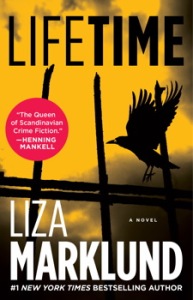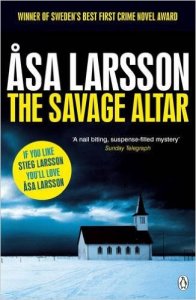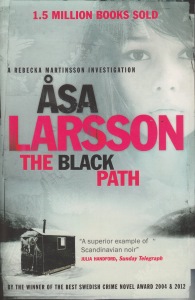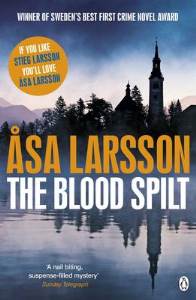Swedish crime is a bit of a departure for me. (It’s a bit of a departure, too, of course, for the murder victims, but that’s by-the-by.) But my tastes in SF are veering towards SF / mystery; thus it seems appropriate to be familiarising myself more with straight mystery, so this is some of what I’ve been reading recently. There’s not really anything connecting these two novels, other than that they’re both by Swedish crime writers. And that the pivotal murder in each book is one in which the victim is not merely killed, but mutilated—in a location within which he had every reason to expect himself safe—by, it’s suspected, a female family member (in one case his wife, in the other his sister, who reacts to arrest with, it seems, some indications of mental instability, and whose only hope of being proven innocent lies with the efforts of a tireless woman playing amateur detective on her behalf. (A somewhat-sympathetic policewoman, looking to defy or outmanoeuvre her male superior officers, also features strongly in each book.) Oh, and both books also manage to name-check the Moomins, something to which I’m somewhat sensitised at the moment. (I’ve no idea whether casual Moomin references are de rigeur in Swedish crime novels; I suppose the two waiting on my to-be-read pile may shed some light on that.) So yes, there are some commonalities between the two stories, which I’ve sought to highlight above. But they are, for all that, very different stories: different crimes, different characters, different story arcs, different writing styles. Let’s get stuck in.

Liza Marklund’s Lifetime (Livstid, 2007, translated by Neil Smith) has newly-separated Stockholm journalist Annika Bengtzon as its protagonist. This is Bengtzon’s seventh outing, so she obviously has form as an investigator; but as the book opens, she has more pressing concerns than the latest gruesome murder, because somebody has just burnt her house down and, without money, documentation, or a change of clothes, she must find shelter for herself and her two young children. The murder victim is a noted police officer, David Lindholm, shot through the head and then the crotch. First on the scene is a policewoman, Nina Hoffmann, an acquaintance, through work, of Bengtzon, and a close friend of David’s wife Julia (also a police officer) who was present at the time of the murder and whose service weapon, found at the scene, is established as the murder weapon. There’s no evidence that anyone other than David and Julia was in the apartment, and Julia’s guilt (of not only her husband’s murder, but also that of their missing four-year-old son Alexander) seems inescapable. But something doesn’t entirely add up, and first Hoffmann and later Bengtzon take up the investigation.
This is a carefully-plotted, detailed, well-researched murder mystery, and I found the latter stages particularly compulsive—which, I guess, is what you want in a crime story. It took its time to gain traction, and it didn’t shy from sociological observation. The central figures of Bengtzon and Hoffmann were very well realised, as was that of Thomas, Annika’s estranged husband, who also plays a significant role. And the settings seemed accurate: Liza Marklund is herself a journalist, and she’s obviously researched Swedish jurisprudence and custodial policies in some depth: there is, in places, a little too much background detail provided, and it sometimes ‘told’ where I felt it should ‘show’. But the murder makes sense, and second-guessing it is unlikely to avail the reader. I enjoyed reading it.

Åsa Larsson’s The Savage Altar (Solstorm, 2003, translated by Marlaine Delargy) is headed up by busy Stockholm tax lawyer Rebecka Martinsson. (‘Tax lawyer’ is also Larsson’s former profession. Write what you know, as they say.) But she’s called to her childhood home of Kiruna, the Swedish mining town somewhat north of the Arctic Circle, by her former flatmate Sanna Strandgård, whose brother Viktor, a charismatic new-age preacher whose evangelical schtick revolves around a near-death experience of a few years earlier, has been found, by Sanna and her two children, butchered in the church within which he had been such an emblematic figure. A murder weapon is found by the police in Sanna’s apartment, along with Viktor’s treasured bible. It appears an open-and-shut case, and the police—represented most vividly by the heavily-pregnant Anna-Maria Mella, who keeps finding excuses not to confine herself to desk work—see little reason to believe Sanna’s protestations of innocence. Rebecka is Sanna’s only hope; and Rebecka is, as she takes pains to explain, merely a tax lawyer, with no experience in criminal investigation outside of spreadsheets and tax tables. Nor does she have any experience with children, and with their mother Sanna arrested Rebecka finds herself with responsibility for eleven-year-old Sara, four-year old Lova, and the dog Virku. So when the threats start …
This is a beautifully-written book, its prose is clean and clear, its descriptive passages reminiscent of Alice Munro, its characterisation as sharp as Raymond Chandler’s. It’s tight, tense, unhurried, deftly paced, and appropriately complex. I found it utterly convincing, and remarkably gripping as events cascade towards the climax. It’s an exceptional first novel.
.
Both of these books fall in a series. Marklund has, to date, produced eleven volumes featuring Annika Bengtzon (many of which have also been made into films), and has also collaborated with James Paterson, on The Postcard Killers (a collaboration which made Marklund the second Swedish author to top the New York Times bestseller list). And there are now six books in Larsson’s Rebecka Martinsson sequence, although it appears to be in hiatus: for the past three years, Larsson has been collaborating with author Ingela Korsell and illustrator Henrik Jonsson on the PAX series of Nordic-mythology-based YA urban fantasy graphic novels which, although they have been translated widely across Europe, do not appear to exist yet in English-language editions.



